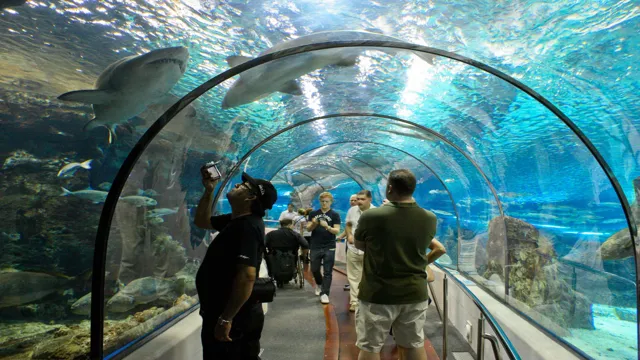List of Largest Aquariums in the World – Unveiling the Wonders
Dive into the Deep: Exploring the Aquatic Marvels
Aquariums have long been more than just tanks filled with water and marine life; they are immersive experiences that transport visitors into the mesmerizing world beneath the waves. Technological advancements and a deepening understanding of marine ecosystems have led to the creation of awe-inspiring aquariums worldwide. In this comprehensive guide, we’ll delve into the details of the largest aquariums globally, each a testament to human innovation and the staggering diversity of marine life.
1. Chimelong Spaceship: Hengqin, China
Our journey begins with the Chimelong Spaceship in Hengqin, China, a true behemoth in the world of aquariums. Boasting a total capacity of an astounding 75,350,969 liters, this aquatic marvel is a testament to engineering excellence. The largest tank alone holds 56,450,136 liters, creating an otherworldly experience for visitors.
Chimelong Spaceship isn’t just about size; it’s an immersive journey into the depths of marine life. Visitors can explore a variety of ecosystems, from the vibrant coral reefs to the mysterious deep-sea habitats. The careful curation of exhibits makes it not just an aquarium but a living, breathing oceanic world.
2. SeaWorld Abu Dhabi: Abu Dhabi, United Arab Emirates
In the heart of Abu Dhabi, the SeaWorld aquarium stands as a testament to the global appeal of marine wonders. With a total capacity of 58,000,000 liters, it offers visitors a chance to witness the grandeur of marine life. The largest tank, an expansive 25,000,000 liters, hosts a diverse range of species, creating an educational and awe-inspiring experience.
SeaWorld Abu Dhabi goes beyond traditional aquarium exhibits. It combines entertainment with conservation efforts, emphasizing the importance of protecting our oceans. Through interactive displays and educational programs, visitors leave not only entertained but also with a deeper understanding of marine ecosystems.
3. Chimelong Ocean Kingdom: Hengqin, China
Returning to Hengqin, China, we encounter another gem in the world of aquariums – the Chimelong Ocean Kingdom. With a total capacity of 48,750,000 liters, it stands as a worthy contender among the largest aquariums globally. What sets it apart, however, is its collection of Guinness World Records.
Since 2014, Chimelong Ocean Kingdom has held records for the largest aquarium, tank, underwater viewing dome, aquarium window, and acrylic panel. The intricately designed exhibits showcase not just the size of the aquarium but the innovation and creativity behind its construction.
4. S.E.A. Aquarium: Singapore, Singapore
Moving to the vibrant city-state of Singapore, we encounter the S.E.A. Aquarium, a marine wonderland with a total capacity of 45,200,000 liters. Holding the Guinness World Record for the largest aquarium from 2012 to 2014, it continues to draw visitors with its captivating exhibits.
The S.E.A. Aquarium is more than just a showcase of marine life; it’s a journey through the diverse ecosystems of the world’s oceans. From the sunlit surface waters to the mysterious depths, each exhibit is meticulously designed to provide an immersive experience. The largest tank, spanning 18,170,000 liters, is a captivating display of the ocean’s grandeur.
5. L’Oceanogràfic: Valencia, Spain
Valencia, Spain, is home to L’Oceanogràfic, a stunning aquarium with a total capacity of 41,600,000 liters. The largest tank, holding 7,000,000 liters, takes visitors on a journey through different marine environments, from Arctic waters to tropical coral reefs.
L’Oceanogràfic is not just a celebration of marine biodiversity but also a commitment to conservation. Through educational programs and exhibits highlighting the impacts of human activities on the oceans, it seeks to inspire visitors to become stewards of marine life.
6. Georgia Aquarium: Atlanta, United States
In the heart of Atlanta, USA, the Georgia Aquarium stands as a testament to the fascination with marine life. With a total capacity of 41,640,000 liters, it held the Guinness World Record for the largest aquarium from 2005 to 2012. The largest tank, an expansive 23,850,000 liters, is a mesmerizing display of aquatic wonders.
The Georgia Aquarium goes beyond being a tourist attraction; it actively contributes to marine research and conservation. Collaborations with scientists and research institutions ensure that the aquarium plays a vital role in understanding and preserving marine ecosystems.
7. Moscow Oceanarium: Moscow, Russia
Russia’s capital, Moscow, is home to the Moscow Oceanarium, an aquatic marvel with a total capacity of 25,000,000 liters. The largest tank, holding 3,700,000 liters, offers visitors a unique glimpse into the diverse marine life found in Russia’s waters and beyond.
The Moscow Oceanarium is not just about showcasing marine life; it’s a celebration of Russia’s rich aquatic biodiversity. From the frigid Arctic waters to the temperate seas, each exhibit tells a story of the unique ecosystems found in this vast country.
8. The Seas with Nemo & Friends: Bay Lake, Florida, United States
Nestled in Bay Lake, Florida, The Seas with Nemo & Friends aquarium boasts a total capacity of 21,580,000 liters. The largest tank, spanning 5,700,000 liters, is a captivating display of marine life inspired by the beloved characters from Disney’s Finding Nemo.
Beyond the entertainment factor, this aquarium emphasizes education and conservation. Through interactive exhibits and educational programs, visitors of all ages gain a deeper appreciation for the oceans and the importance of preserving marine habitats.
9. Aqua Planet Jeju: Jeju Island, South Korea
Our aquatic journey takes us to South Korea’s Jeju Island, where Aqua Planet Jeju stands with a total capacity of 20,000,000 liters. The largest tank, an impressive 10,800,000 liters, showcases the vibrant marine life of the region, creating a visual feast for visitors.
Aqua Planet Jeju is more than just an aquarium; it’s a celebration of the unique marine ecosystems surrounding Jeju Island. Through exhibits that highlight local species and conservation efforts, it fosters a sense of responsibility towards protecting the island’s marine biodiversity.
10. Shedd Aquarium: Chicago, United States
Chicago’s Shedd Aquarium secures the tenth spot on our list with a total capacity of 18,900,000 liters. The largest tank, spanning 7,600,000 liters, offers a mesmerizing underwater spectacle, showcasing the beauty and diversity of marine life.
Shedd Aquarium is not just a destination for aquatic enthusiasts; it’s a hub for research and conservation initiatives. Collaborations with marine biologists and environmental organizations contribute to our understanding of the oceans and the threats they face.
11. Nausicaä Centre National de la Mer: Boulogne-sur-Mer, France
Boulogne-sur-Mer in France hosts the Nausicaä Centre National de la Mer, an aquarium with a total capacity of 17,000,000 liters. The largest tank, holding 10,000,000 liters, is a testament to the rich marine life found in the waters off the French coast.
Nausicaä goes beyond the traditional aquarium experience. Through immersive exhibits and educational programs, it fosters a sense of wonder and respect for the marine environment, encouraging visitors to become ambassadors for ocean conservation.
12. Cube Oceanarium: Chengdu, China
Chengdu, China, introduces us to the Cube Oceanarium, an aquatic wonder with a total capacity of 11,000,000 liters. The largest tank, spanning 10,000,000 liters, is a captivating display of marine diversity, showcasing species from different corners of the world.
Cube Oceanarium is not just a visual spectacle; it’s a journey through the interconnectedness of marine ecosystems. Exhibits highlight the importance of preserving biodiversity and the role each species plays in maintaining the health of the oceans.
13. The Dubai Mall: Dubai, United Arab Emirates
Dubai, known for its opulence, is home to The Dubai Mall aquarium with a total capacity of 10,500,000 liters. The largest tank, spanning 10,000,000 liters, seamlessly integrates shopping with marine exploration, offering a unique and luxurious experience.
The Dubai Mall aquarium is not just a tourist attraction; it’s a symbol of the city’s commitment to blending modernity with environmental awareness. Through exhibits and initiatives, it raises awareness about marine conservation in the heart of the desert city.
14. Osaka Aquarium Kaiyukan: Osaka, Japan
Japan’s Osaka Aquarium Kaiyukan secures the fourteenth spot with a total capacity of 10,000,000 liters. The largest tank, spanning 7,500,000 liters, showcases the diverse marine life of the Pacific Ocean, providing visitors with a unique underwater journey.
Osaka Aquarium Kaiyukan is not just a local attraction; it’s a cultural and educational hub. Exhibits showcase the marine biodiversity of the Pacific and emphasize the importance of global collaboration in preserving our oceans.
15. Okinawa Churaumi Aquarium: Okinawa, Japan
Rounding up our list is the Okinawa Churaumi Aquarium in Japan, boasting a total capacity of 9,800,000 liters. The largest tank, holding 7,500,000 liters, provides a mesmerizing glimpse into the deep blue waters surrounding Okinawa, creating a tranquil and captivating atmosphere.
Okinawa Churaumi Aquarium is not just a tourist destination; it’s a tribute to the unique marine life found in the waters surrounding Okinawa. Through exhibits and conservation initiatives, it seeks to protect and preserve the rich biodiversity of this island paradise.
Honorable Mentions
While our list encompasses some of the largest aquariums globally, it’s essential to acknowledge other remarkable aquatic attractions such as the National Museum of Marine Biology and Aquarium in Hengchun, Taiwan, and the Antalya Aquarium in Turkey. These honorable mentions contribute to the global tapestry of marine conservation and education.
Expert Tips for Maximizing Your Aquarium Experience
Aquarium visits are not just about observing marine life; they’re immersive journeys into the depths of our oceans. To ensure you make the most of your aquarium experience, we’ve gathered expert tips that will enhance your understanding and appreciation of these aquatic wonders.
1. Plan Ahead for Peak Times
Before you dive into the mesmerizing world of the largest aquariums, consider planning your visit during off-peak times. This ensures a more relaxed and enjoyable experience, allowing you to take your time exploring without the hustle and bustle of large crowds.
2. Engage with Educational Programs
Many top-tier aquariums offer educational programs and presentations. Take advantage of these opportunities to gain deeper insights into marine life, conservation efforts, and the unique features of the aquarium you’re visiting. It adds a layer of understanding that transforms your visit into an educational adventure.
3. Explore Behind-the-Scenes Tours
Go beyond the glass walls and consider participating in behind-the-scenes tours if available. These exclusive experiences provide a closer look at the inner workings of the aquarium, from water filtration systems to animal care routines. It’s a chance to see the dedication and effort that goes into maintaining these aquatic wonders.
4. Capture the Moment Responsibly
While it’s tempting to document every mesmerizing moment, be mindful of your fellow visitors. Avoid obstructing pathways with large camera equipment, and consider turning off the flash to minimize disturbance to the marine inhabitants. Responsible photography ensures an enjoyable experience for everyone.
5. Take Your Time at Key Exhibits
Some exhibits within these colossal aquariums are true showstoppers. Allocate extra time at these key locations to absorb the details and appreciate the diverse marine life on display. Patience allows you to witness unique behaviors and interactions that may go unnoticed in a quick walkthrough.
6. Attend Feeding Sessions
Aquariums often schedule feeding sessions for specific marine species. Attend these sessions to witness natural behaviors and learn about the dietary needs of various aquatic creatures. It’s an educational and visually stimulating experience that adds depth to your visit.
7. Utilize Audio Guides
Many aquariums offer audio guides that provide additional information about exhibits. These guides can be invaluable in enhancing your understanding of marine life, offering facts, stories, and conservation insights. Consider bringing your headphones for a personalized, immersive experience.
8. Support Conservation Efforts
Become a part of the larger mission by supporting the aquarium’s conservation initiatives. Many facilities have programs that allow visitors to contribute directly to marine conservation efforts. By doing so, you actively participate in preserving the oceans and the species that call them home.
9. Check for Special Events
Keep an eye on the aquarium’s event calendar. Special exhibitions, lectures, and themed events can provide a unique twist to your visit. From seasonal displays to expert-led discussions, these events offer a dynamic and ever-changing experience.
10. Respect the Marine Environment
Finally, practice responsible tourism by respecting the marine environment both within and outside the aquarium. Learn about sustainable seafood practices, reduce your plastic usage, and share your newfound knowledge with others. Your visit can have a positive ripple effect on ocean conservation.
Embark on your aquarium adventure armed with these expert tips, and you’ll discover that there’s much more to explore than meets the eye. Each aquarium on the list is a doorway to a vast, intricate underwater world, and by following these tips, you can unlock a richer, more meaningful experience.
FAQs: Navigating the Depths of Aquarium Exploration
Embarking on a journey to explore the largest aquariums in the world can raise numerous questions. To guide you through this aquatic adventure, we’ve compiled a set of frequently asked questions along with expert answers. Let’s dive in!
Q1: What Makes an Aquarium One of the “Largest” in the World?
A: The designation of the “largest” aquarium is based on total water capacity and, in some cases, the size of the largest individual tank. Only aquariums with a total capacity exceeding 10 million liters and/or a single tank larger than 5 million liters are included in the list.
Q2: How Accurate Are the Published Capacities of These Aquariums?
A: The capacities listed are based on officially published information and may be subject to change. Some aquariums, while meeting the criteria, may not have publicly disclosed their capacities, making it challenging to include them in the list.
Q3: Are These Aquariums Suitable for All Age Groups?
A: Absolutely. The largest aquariums aim to cater to a diverse audience. They often provide educational programs, interactive exhibits, and family-friendly presentations to engage visitors of all ages.
Q4: Can I Take Photos Inside the Aquarium?
A: Most aquariums allow photography for personal use, but flash photography is often restricted to avoid disturbing marine life. Be sure to check the specific photography guidelines of the aquarium you plan to visit.
Q5: Are Behind-the-Scenes Tours Available to the Public?
A: Many aquariums offer behind-the-scenes tours as part of special programs or memberships. Check with the specific aquarium regarding availability and any additional fees for these exclusive experiences.
Q6: How Long Does It Typically Take to Explore These Large Aquariums?
A: The time needed to explore varies based on individual preferences, but plan for at least a few hours. Some visitors may choose to spend an entire day, especially if the aquarium offers additional attractions or special events.
Q7: Do These Aquariums Contribute to Conservation Efforts?
A: Yes, many of the world’s largest aquariums actively contribute to marine conservation. They engage in research, conservation initiatives, and public education to promote awareness about the importance of preserving our oceans.
Q8: Can I Buy Tickets in Advance, and Are There Discounts Available?
A: Most aquariums offer online ticket purchasing, allowing you to secure your spot in advance. Additionally, many provide discounts for seniors, students, and children. Check the official website or contact the aquarium for specific details.
Q9: Are There Restaurants or Cafés Inside the Aquariums?
A: Yes, many large aquariums feature on-site dining options, ranging from casual cafés to fine dining restaurants. It’s advisable to check the specific aquarium’s amenities beforehand.
Q10: How Can I Contribute to Marine Conservation Efforts Through My Visit?
A: Many aquariums have donation programs or partnerships with conservation organizations. By contributing, you directly support marine conservation initiatives. Look for information at the aquarium or on their website on how you can get involved.
Navigating the world of the largest aquariums is an exciting endeavor. These FAQs provide valuable insights to ensure that your visit is not only enjoyable but also informed. Prepare to be amazed as you uncover the mysteries of the deep blue in these extraordinary aquatic habitats.
Conclusion: Diving into the Vast Aquatic Realms
In conclusion, the world’s largest aquariums are more than just places to observe marine life; they are gateways to understanding and appreciating the intricate ecosystems that make up our oceans. From the futuristic Chimelong Spaceship to the vibrant S.E.A. Aquarium, each of these aquariums offers a unique and awe-inspiring experience. As we continue to push the boundaries of aquatic exhibit design, these marvels stand as testaments to our fascination with the mysteries of the deep. Whether you’re an avid marine enthusiast or a casual visitor, exploring these aquariums promises an unforgettable journey into the diverse and captivating world beneath the waves. So, dive in and let the wonders of the ocean unfold before your eyes.






